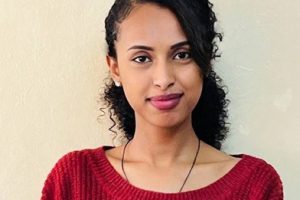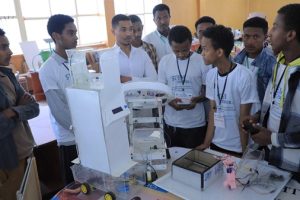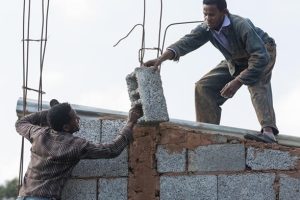
The Irreechaa festival is celebrated every year at the beginning of Birraa (spring), new season after the dark and rainy winter season. Traditionally, the Oromo practiced Irreechaa ritual as a thanks giving celebration twice a year in autumn and spring to praise Waaqa (God) for peace, health, fertility and abundance they were given with regards to the people, livestock, harvest and the entire Oromo land.
Scholars and experts said that Irreechaa is celebrated as a sign of reciprocating Waaqa (God) in the form of providing praise for what they got in the past, and is also a forum of prayer for the future. In such rituals, the Oromo gather in places with symbolic meanings, such as hilltops, river side and shades of big sacred trees.
Approached by the Ethiopian Herald Researcher of the Oromo history Birru Tsegaye told that Irreechaa is the major binding force among the Oromo people and the ritual celebration which accommodates all religions across the country. The Oromo people have special place for nature that is why they gather in places like river side, shades of big sacred trees which is called in Afan Oromo “Oda” and hilltops as well.
Irreecha is celebrated in many parts of Ethiopia and the most popular one takes place at Bishoftu (DebreZeit) town 25KM south-east of Addis Ababa and by the shores of Lake Hora Arsadi and across the country in different regions. This year the festival is celebrated for the first time in Finfinne (Addis Ababa) at Hora Finfinne after 150 years. The Oromo societies from different regions of the country travel to Hora Finfinne and celebrate the festival and about eight million people are expected to attend the event.
Oromos have an annual ritual of celebrating nature and thanksgiving to their God the creator called Waqa. The celebration involves making offerings on designated big tree and making recitations of good wish, blessing and sprinkling what is considered holy water on the participants.
This ritual is also an occasion where Oromo people of Christian, Catholic, Muslim and protestant and other faith groups come together to participate in the ceremony. This ceremony is getting increasing popularity among tourists and now this year the festival is celebrated in Hora Finfinne (Addis Ababa) after 150 years. This by itself indicated that the tradition is getting popularity and acceptance by different nations and nationalities of the country and abroad Biru says.
He indicated that historically, Irreechaa has been understood and practiced within the context of the Oromo religion, Waaqeffannaa, a belief in one supernatural power called Waaqa (God). However, Irreechaa accommodates non-religious aspects of the Oromo culture, and thus has played significant role in building the Oromo identity and sense of unity. In the contemporary context, where the ritual brings Oromos across different walks of life, Irreechaa should be understood more as an arena where the Oromo identity is articulated, reconstructed, built and practiced, rather than as a mere thanks giving celebration.
In Oromia, the core center of Irreecha celebration has been around Hora Arsadi in Bishoftu town, some 25KMs to the south of Finfinne, the capital city. Annually, particularly during the Irreecha birraa the Autumn Irreechaa in September or October, the Oromo from different parts of the country come together and celebrate the ritual. Irreechaa became not only a thanks giving practice rather it served as an arena where the Oromo people across religious boundaries could meet and share their common identity.
Detlet Moritz, a German tourist says “The celebration is so interesting which gathers many people and I attended the event for over four times and it is so incredible. I traveled to different parts of the country in Ethiopia and Ethiopia has lots of tangible and intangible heritages.”
Moritz said that millions of people gather together to celebrate the event and this is one indication of unity among the Ethiopian peoples it is important to celebrate the event across the country not only in Oromia. Everything is beautiful when there is unity and love among the societies of the nations and the continents as well. This kind of festivals promotes integration among the society both in the country and abroad.
Senior Expert at Oromia Culture and Tourism Sintayehu Tola says Irreechaa combines both religious and cultural aspect of the Oromo people. Gada is inscribed as intangible heritage at UNESCO which world is known it by the socio-political aspect of the Oromo people. Gada is the indigenous democracy of Ethiopia practiced by Oromo people before hundreds thousands of years. Gada is the concrete socio-political system of Oromo people and it the core defining identity of Oromo people. The nexus between Gada and Irreechaa is transitional period and celebrated by every religious person in Ethiopia and abroad.
Birru said that Irrecha is part and parcel of the Gada system which connects human beings together. Irreechaa is all beyond ritual and it bridges natural and manmade things through season. The ritual is mutual relationship between human and super natural ones.
It is all about forgiveness, love and unity which connects past with the future generations and connects the Oromo live in and outside the country. It accommodates and transcends boundary and religions. The festival is collective conscience of togetherness which connects the Oromo society across the world.
The Ethiopian Herald October 5/2019
BY HAILE DEMEKE





